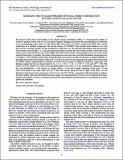Por favor, use este identificador para citar o enlazar a este item:
http://hdl.handle.net/10261/109595COMPARTIR / EXPORTAR:
 SHARE SHARE
 CORE
BASE CORE
BASE
|
|
| Visualizar otros formatos: MARC | Dublin Core | RDF | ORE | MODS | METS | DIDL | DATACITE | |

| Campo DC | Valor | Lengua/Idioma |
|---|---|---|
| dc.contributor.author | Lira, Paulina | - |
| dc.contributor.author | Videla, Liza | - |
| dc.contributor.author | Wu, Yanling | - |
| dc.contributor.author | Alonso-Herrero, A. | - |
| dc.contributor.author | Alexander, M. | - |
| dc.contributor.author | Ward, M. J. | - |
| dc.date.accessioned | 2015-01-21T11:59:56Z | - |
| dc.date.available | 2015-01-21T11:59:56Z | - |
| dc.date.issued | 2013 | - |
| dc.identifier | doi: 10.1088/0004-637X/764/2/159 | - |
| dc.identifier | issn: 0004-637X | - |
| dc.identifier | e-issn: 1538-4357 | - |
| dc.identifier.citation | Astrophysical Journal 764(2): 159 (2013) | - |
| dc.identifier.uri | http://hdl.handle.net/10261/109595 | - |
| dc.description.abstract | We present results from model fitting to the spectral energy distribution (SED) of a homogeneous sample of Seyfert II galaxies drawn from the 12 μm Galaxy Sample. Imaging and nuclear flux measurements are presented in an accompanying paper. Here we add Spitzer/IRS observations to further constrain the SEDs after careful subtraction of a starburst component. We use the library of CLUMPY torus models from Nenkova et al. and also test the two-phase models recently produced by Stalevski et al. We find that photometric and spectroscopic observations in the mid-IR (λ ≳ 5 μm) are crucial to properly constrain the best-fit torus models. About half of our sources show clear near-IR excess of their SEDs above the best-fit models. This problem can be less severe when using the Stalevski et al. models. The nature of this emission is not clear since best-fitted blackbody temperatures are very high (∼1700-2500 K) and the Type II classification of our sources would correspond to a small probability to peer directly into the hottest regions of the torus. Crucially, the derived torus parameters are quite robust when using CLUMPY models, independently of whether or not the sources require an additional blackbody component. Our findings suggest that tori are characterized by , σ ≳ 40, τ ≲ 25, ∠i ≳ 40°, Y ≲ 50, and A los v ∼ 100-300, where is the number of clouds in the equatorial plane of the torus, σ is the characteristic opening angle of the cloud distribution, τ is the opacity of a single cloud, ∠i is the line-of-sight orientation of the torus, Y is the ratio of the inner to the outer radii, and Alos v is the total opacity along the line of sight. From these, we can determine typical torus sizes and masses of 0.1-5.0 pc and 104-106 M⊙, respectively. We find tentative evidence that those nuclei with detected hidden broad-line regions are characterized by lower levels of extinction than those without one. Finally, we find no correlation between the torus properties and the presence of circumnuclear or more global star formation. © 2013. The American Astronomical Society. All rights reserved. | - |
| dc.description.sponsorship | P.L. is grateful for the financial support by Fondecyt grant No. 1080603. L.V. gratefully acknowledges fellowship support by project MECESUP UCH0118, and partial support from Fondecyt project 1080603. This publication was also financed by the ALMA-Conicyt Fund, allocated to the project No. 31060003. A.A.-H. acknowledges support from the Spanish Plan Nacional de Astronomía y Astrofísica under grant AYA2009-05705-E. | - |
| dc.publisher | American Astronomical Society | - |
| dc.publisher | Institute of Physics Publishing | - |
| dc.relation.isversionof | Publisher's version | - |
| dc.rights | openAccess | - |
| dc.title | Modeling the nuclear infrared spectral energy distribution of type II active galactic nuclei | - |
| dc.type | artículo | - |
| dc.identifier.doi | 10.1088/0004-637X/764/2/159 | - |
| dc.relation.publisherversion | http://dx.doi.org/10.1088/0004-637X/764/2/159 | - |
| dc.date.updated | 2015-01-21T11:59:56Z | - |
| dc.description.version | Peer Reviewed | - |
| dc.language.rfc3066 | eng | - |
| dc.contributor.funder | Ministerio de Economía y Competitividad (España) | - |
| dc.contributor.funder | Fondo Nacional de Desarrollo Científico y Tecnológico (Chile) | - |
| dc.contributor.funder | Comisión Nacional de Investigación Científica y Tecnológica (Chile) | - |
| dc.identifier.funder | http://dx.doi.org/10.13039/501100003329 | es_ES |
| dc.identifier.funder | http://dx.doi.org/10.13039/501100002850 | es_ES |
| dc.identifier.funder | http://dx.doi.org/10.13039/501100002848 | es_ES |
| dc.type.coar | http://purl.org/coar/resource_type/c_6501 | es_ES |
| item.fulltext | With Fulltext | - |
| item.openairecristype | http://purl.org/coar/resource_type/c_18cf | - |
| item.cerifentitytype | Publications | - |
| item.grantfulltext | open | - |
| item.openairetype | artículo | - |
| Aparece en las colecciones: | (IFCA) Artículos | |
Ficheros en este ítem:
| Fichero | Descripción | Tamaño | Formato | |
|---|---|---|---|---|
| TYPE II ACTIVE GALACTIC NUCLEI.pdf | 1,63 MB | Adobe PDF |  Visualizar/Abrir |
CORE Recommender
SCOPUSTM
Citations
51
checked on 20-abr-2024
WEB OF SCIENCETM
Citations
51
checked on 25-feb-2024
Page view(s)
284
checked on 24-abr-2024
Download(s)
274
checked on 24-abr-2024
Google ScholarTM
Check
Altmetric
Altmetric
NOTA: Los ítems de Digital.CSIC están protegidos por copyright, con todos los derechos reservados, a menos que se indique lo contrario.
